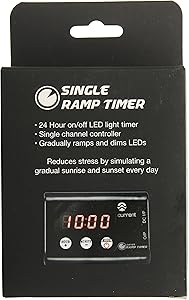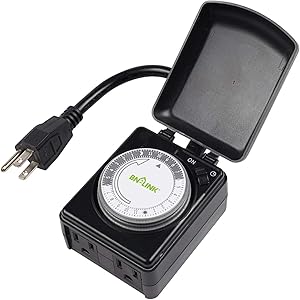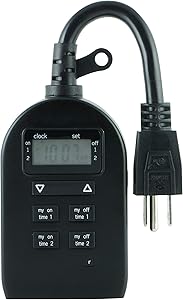Aquarium automation uses high-tech electronics, Wi-Fi, and computer technology to handle many of the everyday tasks we used to perform by hand.
Many of today’s LED aquarium lights come with lighting programs that automatically turn on/off, recreating sunrise and sunset.
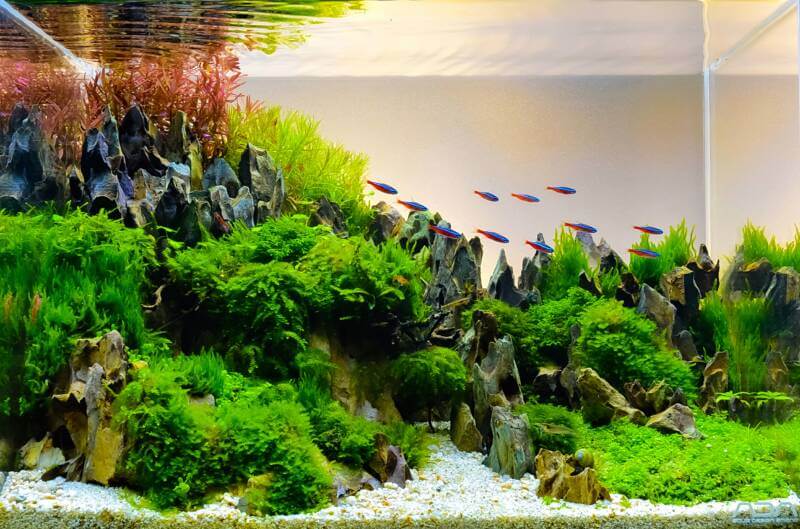
But what if you don’t have a high-tech aquarium light? You can still automatically control your lights with an add-on timer.
[toc]
Overview
There’s really no need to go through the routine of turning the aquarium light on in the morning and off at night. We often get busy and forget to switch the light on or off.
What happens during a vacation or long holiday? The fish and plants sit in darkness or live for days in a fully illuminated aquarium.
You may be thinking: “So what, fish don’t care”. Oh, but they DO! Scientists have long been studying something called “circadian rhythms”.
A circadian rhythm is a natural, internal clock that regulates biological processes throughout a 24-hour period.
Biologists have discovered fish, and even aquatic plants have an internal rhythm that regulates their behavior and metabolism.
This internal clock is based on the Earth’s natural 24-hour lighting cycle, including sunrise and sunset.
Plants & Lighting
https://www.youtube.com/watch?v=6EazuPv-0yU
We know plants are affected by day length. Their growth and reproduction are based on light cycles that affect the plant’s biological clock.
Research has shown plants grown under artificial lights will have the best growth when the lights turn on and off at about the same time as sunrise and sunset.
This makes logical sense because everyone knows plants need light for photosynthesis. But who could have imagined that mimicking natural day length “makes plants happy”?
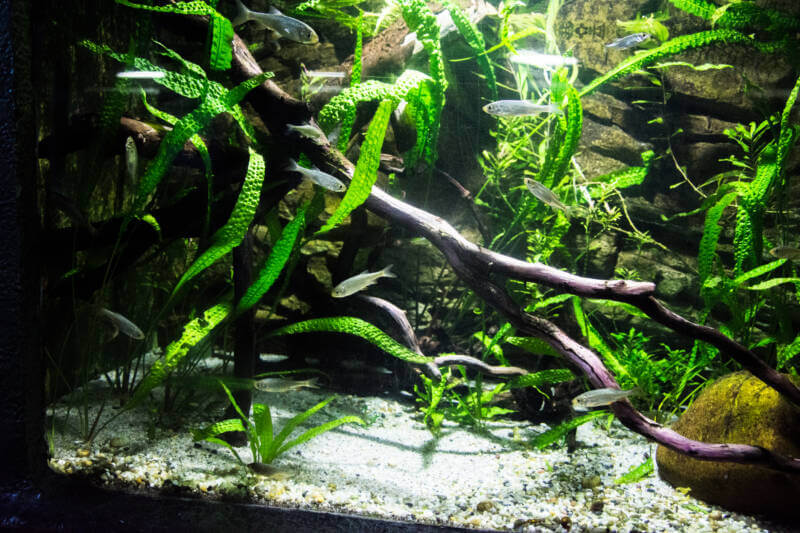
We can assume aquarium plants will thrive best when the aquarium light is on a life-like photoperiod too.
But plants aren’t the only aquatic life that is affected by lighting.
Fish & Lighting
Biologists have also discovered that fish respond to the light cycle! When you turn the light on and off has a direct impact on your fish’s health.
Light acts as a signal, regulating the fish’s immune system and metabolism.
Fish have a light-sensing organ called the pineal gland, located above the brain.
Some fish have fewer pigment cells over the pineal organ, so light can be easily pass through the skin. The eyes and even skin also act as light “receptors”.
Biologists at the University of Maryland discovered that blind cave fish (Mexican tetra), fish with no eyes, can sense a shadow that passes over them.
Observations in the research aquariums showed that the cave fish always sought out the aquarium’s shady area, even if it was caused by a moving hand.

This probably helped the fish avoid predators by hiding out in shady spots.
By sensing light, aquarium fish develop an internal rhythm that controls feeding, immune system, cell repair, and even sleep cycles.
But there’s more! Reef corals contain algae that live inside their fleshy tissue. Coral and algae help each other by sharing nutrients each need.
The corals synchronize feeding and algae activity based on photoperiod.
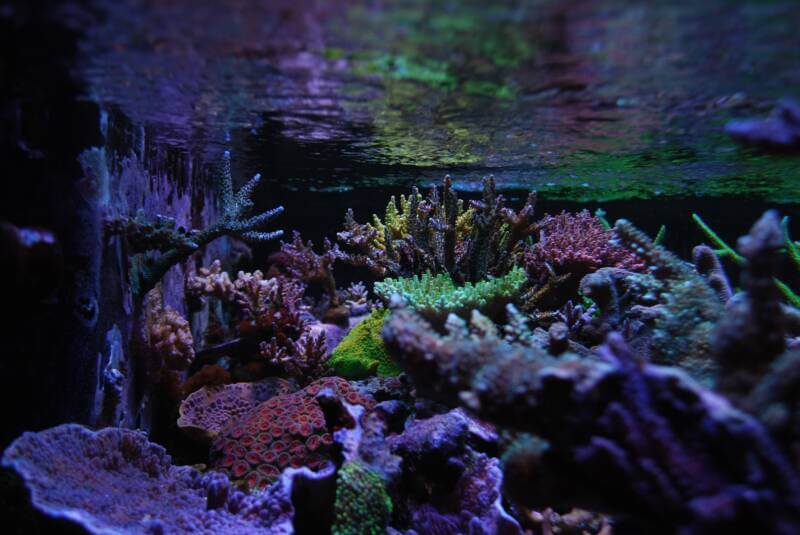
As the latest research shows, lighting and the on-off cycle is important to aquarium life.
Algae growth & Lighting
Another important factor for controlling how long your aquarium light is on is algae growth. Algae are always present in all aquariums.
It’s impossible to eliminate these tiny plants. You wouldn’t want to either. Many fish graze on algae cells and the zooplankton that crawls on the algae.
But no one wants algae growing all over the glass, plants, and ornaments.
Since algae are plants, they get their energy through photosynthesis. Running the aquarium light day and night increases the chances of excess algae growth.
If you’re not at home, forget or have an irregular schedule, it’s easy to just leave the aquarium light on.
But a simple aquarium timer will solve this problem and even reduce the amount of algae scraping and aquarium maintenance required to keep your aquarium looking good.
How long should the aquarium light be on?
The answer depends on several factors. The most complex aquarium is a reef tank.
The corals are very sensitive to light intensity and day length. Most reef aquarists have determined the specific day length and intensity that works for their aquarium.
Many reef lighting fixtures have built-in ramp-up and ramp-down controls. This simulates the gradual sunrise and sunset, with full intensity lighting for a few hours around the middle of the day.
If you’re keeping live plants, around 10 hours works well for many planted aquarium aquarists.
You definitely want the aquarium to be illuminated when you’re home so you can enjoy the tank. A 10 to 12-hour lighting period covers most people’s lifestyles.
Top Rated Aquarium Light Timers
You don’t need a special aquarium timer to turn your aquarium light on and off. The Dewenwills timer is a simple rotary timer that runs on a 24-hour cycle.
Simply set the on and off period by pushing the tabs that correspond to the hours you want the light on and off.
The timer runs on 30-minute increments. This means that during every 24-hour period, you can adjust the day and night length within 30 minutes.
This timer has one grounded outlet. The grounded power cord is 24-inches long. This gives you the freedom to place the timer where you want it.
The timer mechanism is enclosed in a splash-proof housing. This is a good safety feature if you’re prone to accidental splashes when working on your tank.
The grounded power cord is UL-listed. If power is lost, you’ll have to reset the timer to match the current time.
2. Current Single Ramp Timer
Current is known worldwide for their advanced LED lighting systems. They’ve created this time to work with their True Lumen marine lighting fixtures.
At the “on” time, the Ramp Timer slowly runs a sunrise and gently increases the lighting level to full brightness over a period of 15 minutes.
When the programmed “off” time is reached, it gradually dims the light over 15 minutes before turning off.
This simulates the gentle dusk to night effect. The ramp feature prevents sudden or stressful light shocks.
The next day, the schedule starts all over again, creating a natural circadian rhythm to the 24-hour light-dark cycle.
The Ramp Timer has a large LCD display and keypad for easy set-up. This unit can be set with an on/off or on/off with a 15-minute ramp up and dim down.
A manual button lets you turn your lights on or off instantly. This Ramp Timer™ works with TrueLumen LED Lights, which run on 12-24VDC using a standard DC plug.
The internal memory will store your pre-programmed times in case of power failure.
3. BN-LINK Compact Outdoor Mechanical Timer
This mechanical rotary timer comes with a grounded 6-inch power cord. The manufacturer says the protective housing is “waterproof,” but this is incorrect. The housing is water-resistant.
It can’t be drenched with water, but an occasional splash will drip off the cover.
The timer works on a 24-hours cycle. The rotary timing device is set-up by pushing down a pin when you want the light on and the pin that corresponds to when you want the light to turn off.
Remember to push down all the pins in between the On and Off-cycle.
The BN-LINK has two grounded outlets. The maximum load is 15 amps split between the two outlets. Both outlets are controlled by the timer.
It also has a manual ON and OFF button. If power is lost, you’ll have to reset the timer to match the current time.
4. NICREW Aquarium LED Light Inline Dimmer
Nicrew manufactures a variety of pet products, including inexpensive LED aquarium lights.
The NICREW Aquarium LED Light Inline Dimmer is not an automatic time. It is a manual dimmer that allows you to slowly turn up or down certain LED aquarium fixtures.
This is a nice feature for very basic single-channel LED lights, especially if you don’t need an automatic timer but want dimming control.
You can use an On-Off timer to automatically control your light.
For example, you can dim the light an hour before bedtime. Then the timer will turn the light off and then on the next morning.
Since the NICREW dimmer dims the light, you can manually increase the lighting before leaving home.
Note that this dimmer works with Basic LED aquarium lights that use a 5.5mm x 2.1mm barrel connector and 5V to 24V DC to power the lights.
There are adapters that let you match the barrel size, but the light must use the same power range. The dimmer connects in between the light’s power supply and the light fixture.
5. myTouchSmart Indoor/Outdoor Plug-in Digital Timer
The myTouchSmart timer is geared toward holiday lighting and small fountain pumps. But it will also work well for a basic aquarium lighting program.
Unlike a rotary mechanical timer, the myTouchSmart unit is a digital timer.
There are no moving wheels or pins to adjust. Just set the actual time when you want the single outlet to turn on and then when you want it to turn off.
But there’s more. You can create a second photoperiod, so the light comes on and off at a different interval.
The LCD screen makes it easy to program and see the current time of day and which program is running the lights. The timer has an internal battery back-up that saves the time of day and programming in case of power failure or if you need to unplug the time.
The digital timer is encased in a splash-resistant housing.
Recommendations
For basic on and off lighting control, the DEWENWILS Outdoor Outlet Timer has what you need.
The 2-foot power cord makes it easy to plug in under the aquarium. Set-up is simple and works with any type of aquarium light.
The myTouchSmart timer is a digital timer that has no mechanical timer gears to wear out. It has a battery back-up, which is helpful if your location is prone to power outages.
If you’re into a more sophisticated timing system, I recommend choosing an LED aquarium light with built-in ramp timing or is compatible with an add-on ramp timer.
This is the only way to get the smooth lighting transitions that many reefs and planted aquarium enthusiasts are looking for.
If you have comments or questions, please leave them below!


